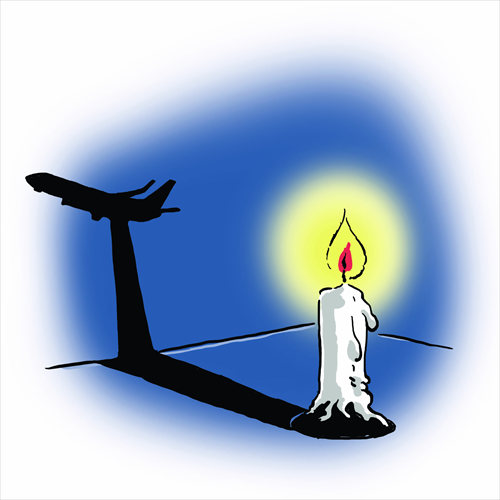
Illustration: Liu Rui/GT
Sky News reporter Colin Brazier has found himself in hot water after picking through the possessions of a victim of the MH17 crash live on air.
Brazier, a veteran journalist, seemed to suddenly realize what he was doing halfway through the process, dropping the items and backing away. But his eagerness to frame a sentimental image was roundly blasted by the UK media, and by the families of victims.
By the time Brazier arrived, the MH17 victims had already endured numerous reports of the desecration, even pillaging, of the crash site by pro-Russian militias.
An area that should have been sealed off immediately and treated with careful respect, both for practical and humane reasons, was instead trampled randomly.
For Sky's British viewers, the scenes were a tragic contrast with the last air disaster of this scale on British soil, the destruction of Pan Am Flight 103 over the small Scottish town of Lockerbie in 1983, killing all on board and 11 townsfolk on the ground.
There, local residents provided massive support to victims' families and aid workers, housing, feeding, and helping them in every way possible.
Many of the relatives of victims still return to the town, not only to mourn their families but to maintain ties of friendship forged out of disaster.
Amid the paranoia and bloodshed of eastern Ukraine, such an outcome is impossible. But Brazier's actions draw attention to the question of how to properly honor the dead in the media, if not on the ground.
Brazier's rifling through the luggage was an extension of a long-standing tradition of media ghoulishness harking back to the London press' fascination with the grisly details of Jack the Ripper's victims.
At its worst, this is mixed with a mawkish sentimentality that transforms the victims from real people into mere targets for emotional ejaculation by reporters and viewers.
Even the Mail story condemning Brazier ended "Elsewhere in the fields of wildflowers and rippling corn, sitting incongruously among aeroplane parts and electrical innards, were heartbreaking little pieces of evidence of the child victims aboard Flight MH17. A girl's 'Secret Diary' could be seen next to a tiny silver bracelet glinting in the sun and a packet of unopened Haribo sweets."
Drop the Dead Donkey, an ingenious parody of Sky News done even before the 24-hour-news cycle had become the norm, brilliantly spoofed this with a reporter carrying his own battered teddy bear, ready to be thrown onto and filmed at any accident or massacre site he visited.
In China in the late 1930s, the authorities took already bloody scenes of Japanese-caused devastation and staged sentimental touches to appeal to the Western press.
Such sentimentality tends to steer away from images of the dead themselves.
This has some good cause; after all, few parents want to see their child's mutilated corpse splashed across the television.
But without the visceral reminder of the damage done, such horror, especially in the case of war, can become washed away by the euphemisms of "collateral damage." There is more of a case for torn bodies on the TV screen than children's toys.
It's easy to forget the victims who once flashed up on our news screens. In MH17's case, the Russian media has largely focused on technical details and conspiracy theories.
A more dignified way of remembrance, in contrast, is the new tendency to give miniature obituaries of individual victims.
While practiced before, this became more prominent after the New York Times' provision of a detailed remembrance of every single victim of the September 11 attacks, spanning months of publication.
In an age of social media and easy contact, it's become far easier than before to celebrate life, not create sentimental images around death, after disaster.
The author is an editor with the Global Times. jamespalmer@globaltimes.com.cn
